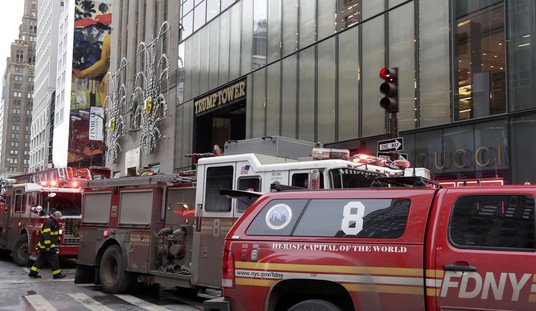In the seventh year of Barack Obama's administration, the economy is still getting failing grades that have been the hallmark of his trouble-filled presidency.
While he continues to go about the country telling voters that his policies are working, this week's dreary economic data tell a far different story.
The bleak headlines in the nation's major newspapers tell the story in its bluntest terms.
"Stocks fall on disappointing economic data," said USA Today.
"U.S. stocks fall on weak economic data," blares The Wall Street Journal, with this subhead: "Private payrolls rise less than expected in March, adding to concerns about U.S. growth."
What these stories say is that the economy is growing even more slowly than before; incomes remain largely flat; factories are getting fewer orders than they'd hoped; and many Americans now say they worry about money and are keeping a tighter grip on their wallets.
Recommended
Meantime, Fed Chairwoman Janet Yellen made it clear in her news conference last week that she continues to be concerned about the economy's slowdown, and was in no hurry to raise interest rates anytime soon.
Let's take these one at a time.
Our economy grew at little more than 2 percent in the fourth quarter of 2014, according to the U.S. Commerce Department's final estimate -- leading many economists to lower their growth estimates for the first quarter of 2015.
Wall Street economists now estimate that "economic output will rise in the first quarter at an annual rate of just over 1 percent," the New York Times reported last week.
Barclays lowered its first quarter growth rate forecast to 1.2 percent, as did Macroeconomic Advisers, a respected forecasting firm. It had been predicting 2.4 percent growth in the first quarter.
This is a pathetic growth rate, compared to the strong recovery in the 1980s when quarterly GDP rates soared between 4 and 8 percent, fueled by across-the-board tax cuts enacted under the Reagan administration.
The most troubling sign of the economy's weakness came this week when the Institute for Supply Management reported that manufacturing growth plunged in March to its slowest rate in nearly two years -- the result of declining durable goods orders and "stagnant employment."
Meantime, the monthly jobs survey by Automatic Data Processing Inc, and forecasting firm Moody's Analytics reported Wednesday that employers added only 189,000 jobs last month, well below the 225,000 most economists were forecasting.
There were other signs of an economic slowdown, too, including a decline in construction spending, falling sales among automakers, including Ford and GM, and a weak real estate market.
Forecasters have said that lower gasoline prices would lead to increased consumer spending, but that has not proved to be the case. Income-strapped consumers are holding on to their money as fears spread of a slowdown in the economy.
Consumer spending barely rose by a minuscule 0.1 percent in March, following a 0.2 percent decline in both January and February, the Commerce Department said.
If anyone, besides Obama, thinks people are feeling more confident about this economy, the latest poll by the Gallup organization should disabuse them of that.
This week, it asked Americans if this statement applied to them: "In the last seven days you have worried about money." Over a third of those polled said it did.
That's not hard to understand when economic data last month showed that wages barely rose and for very many Americans, good, full-time jobs were still hard to find.
Forget those phony, seasonally-adjusted job numbers that come out of the Labor Department which refuses to count millions of discouraged workers -- who've stopped looking for a few weeks -- as unemployed.
The jobless rate wasn't 5.6 percent as the government tells us, but 6.4 percent, according to this week's daily poll by Gallup. And for those who need full-time work but have to settle for part-time jobs, Gallup puts the underemployed rate at a shocking 15.5 percent.
Little wonder then that Obama's job approval polls have been stuck in the mid-forties for a long time, according to its daily tracking surveys.
Economic confidence surveys aren't anything to write home about, either. "The index has been slightly negative in five out of the past six weeks," Gallup says.
Seven years is a very long time to wait for a significant improvement in the economy, especially when the record books tell us that the average length of recessions we've had over the decades is about two years.
Economists say there are two kinds of recoveries. One is a V-shaped recovery where the economy soars straight up into a robust, high growth rate, job creating trajectory.
That's what happened in the Reagan recovery when in a single month (September 1983) his policies created over one million jobs.
Then there is the so-called Obama recovery where the economy remains sluggish year after year, growth remains perpetually anemic, capital investment is mediocre, and it never fully recovers.
Indeed, when Federal Reserve chair Yellen talked about the economy last week, she still talked about it in terms of the recovery -- as in a work in progress.
Her reluctance to say when the Fed will begin raising interest rates, and take the Obama economy off its life support system, speaks volumes about its weakness.
Instead, she said that "the appropriate time has not yet arrived."
Translation: The Obama economy is still far too anemic to stand on its own two feet without the Fed propping it up.
Meantime, let's face it. This economy isn't going to ever regain its full health and vigor until the voters put someone else in the Oval Office who knows what it takes to get the engine of growth running at full throttle again.


